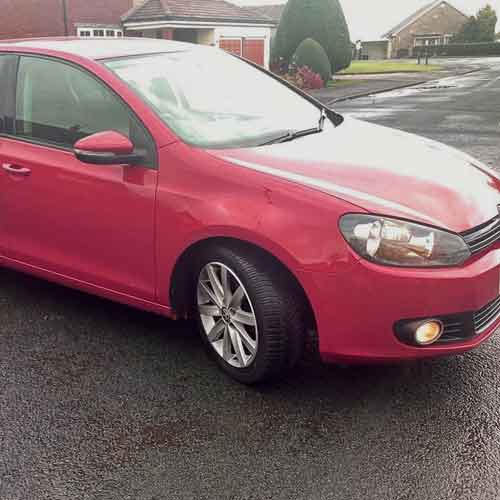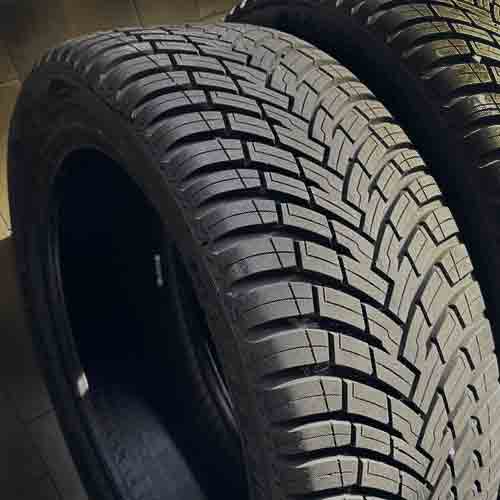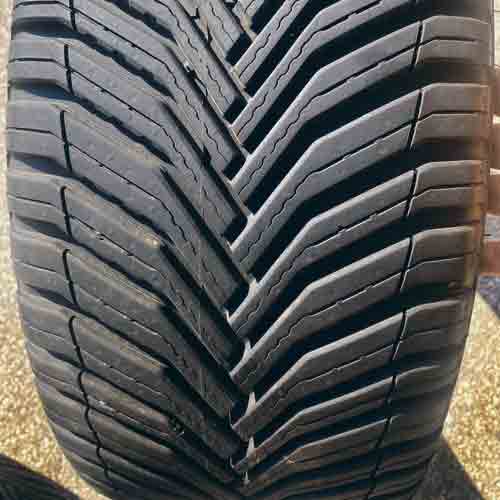Both the Pirelli Cinturato SF2 and the Michelin CrossClimate 2 are pretty great “all-weather” options, bringing unique strengths to the table. That’s why both of them made it to my list of top grand touring tires.

If you’re wondering, you can check out “the list” here: https://tiredriver.com/best-grand-touring-all-season-tires/
Key Takeaway
Michelin Crossclimate 2 excels in:
- Enhanced directional grip for improved road contact.
- Superior handling at corner entry, reducing lap times.
- Better wet braking with specialized siping for grip.
- Advanced winter performance with wider siping and adaptive rubber.
- Increased ride comfort from polyurethane foam and softer rubber.
Detailed Discussion on Michelin’s tire: https://tiredriver.com/michelin-crossclimate-2-review/
Pirelli Cinturato All Season SF2 excels in:
- Improved traction and control in mid-cornering and exiting turns.
- Faster handling and aquaplaning resistance in wet conditions.
- Quieter ride due to sleek lateral grooves and rubber composition.
- Reliable traction in temperatures just above freezing.
Detailed Discussion on Pirelli’s tire: https://tiredriver.com/pirelli-cinturato-all-season-sf2-review/
Main Features of Both Tires
The Pirelli Cinturato All Season SF2 features an eye-catching directional tread pattern.

Despite its V-shaped arrangement, the tire can be distinctly divided into five separate block columns or ribs.
This is because of the longitudinal voids, splitting up the blocks, or should I say interconnecting the lateral-grooves (these arrow-shaped lugs make) together, enhancing hydroplaning resistance.
Now, the tread’s middle most area is very crowded up, where L or F shaped lugs can be seen, (L-shaped if you consider the central most zigzag circumferential groove, and F-shaped if you consider the notches facing outwards).
And lugs get further spaced apart towards shoulders.
Though all these lugs feature similar linear siping pattern.
Speaking of internal construction, the tire is constructed with a 2-ply polyester casing, two steel belts, and a single polyamide cap ply.
In contrast, the Crossclimate 2 also exhibits a directional pattern but with a more streamlined design.

I mean its V-shaped lugs aren’t as “swooping”, or “trumpet-shaped” as Pirelli likes to put it.
They’re only divided towards the outer edges by longitudinal slits, which delineate the shoulders from the central section.
Now sure the shoulder lugs are very similar compared to Pirelli’s tire. But things get very different as we go towards the middle.
First off, you get snow-vices (notches on the lug sides) for enhanced snow traction.
Additionally, the siping evolves from linear to wave-like interlocking pattern, (seen on the middle-most lug area).
Though there aren’t any notches here (like seen on the F-shaped blocks on Pirelli). But yes, this tire does have the same internal construction. Well at-least on the paper.
Info on Sizes
The Michelin Crossclimate 2 comes in 16 to 22 inches with following specs.
- Speed ratings: H and V.
- Load ratings: SL and XL.
- Tread depth range: 10.5/32″ (on all)
- Weight range: 25 to 36.5 lbs
- Tread mileage rating: 60k miles.
- UTQG: 640 B A.
Pirelli Cinturato All Season SF2 comes in 65 total sizes, in 15 to 20 inches wheels. And they have the following specs.
- Speed ratings: H and V.
- Load ratings: SL and XL.
- Weight range: 16 to 32 lbs.
- Tread depth: 10/32″ (or 8 mm) on most sizes.
- UTQG: 500 A A.
- Treadwear warranty: None.
Both tires offer 3pmsf and M+S ratings. And SF2 also has some run flat sizes.
Overall Dry Performance
A thorough assessment of the tire’s traction and steering response is best done by examining its dry performance. Let’s simply this process.
Directional Grip
How well a tire grips, especially when you hit the brakes, mostly comes down to its central tread, which is the part that hangs onto the road when you’re cruising straight.
And here, the Michelin CrossClimate 2 really stands out (as you may have noticed by now, its ranked best for braking in my list of top grand touring tires).
It’s got a killer combo: a directional tread that keeps things tight and orderly at the center for better road contact, interlocking central lugs that zigzag to amp up the grip, and a rounded contact patch that spreads the tire’s weight evenly for smooth and quick stopping.
For you info: While Michelin here takes the lead (in terms of dry braking), the Kleber Quadraxer 3 and Hankook Kinergy snag the the second and third spots. I’ve reviewed both of these tires as well. You can find them out with the help of search bar.
Overall Handling
Handling is the big boss when it comes to a tire’s dry performance. It’s a mix of everything: braking, side grip, and how quickly the tire responds to steering.
Now here, although Pirelli SF2 offers better “subjective” scores in my lap tests, both tires end up with similar results, showcasing similar averaged lap times overall.
But let me be more specific. So “handling” is a three-act play:
- Corner entry
- Mid-cornering
- Exiting the turn
Pirelli rocks the last two parts, but Michelin steals the show right at the entry, where it breaks down quicker before each corner, shaving off precious seconds on the laps.
On the flip side, Pirelli has this cool advantage: better traction.
It zips out of corners faster and, thanks to being lighter, it doesn’t press down as hard on the lugs.
Why does that matter? Well, because less pressure means the lugs are less likely to bend.
And with lugs bending, they take time to snap back to shape, which means a delay between your steering and the car’s response, leading to slower feedback and reaction times.
So yes, although its slightly complicated, overall both tires are equally great here, at the end of the day.
Quick recommendation: Jumpstart your tire selection at my main all-season tire page, your go-to for the best advice. Navigate here: https://tiredriver.com/all-season-tires/
Wet Performance
In simple terms, the overall wet performance of a tire is determined by its ability to effectively clear water from the road surface as it moves. This results in better hydroplaning resistance and enhanced grip and traction in wet conditions.
Let’s examine these two key factors more closely.
Aquaplaning Resistance
Hydroplaning is another word for floating of a tire, when a layer of water gets trapped under the tire, making the wheels lose all traction.
To tackle this, tires have grooves designed to swoosh water away, and how well they do this is key to beating hydroplaning.
Now, both tires we’re looking at have a directional design, which works like a charm in pushing water from the center to the edges and out through V-shaped grooves.
But when you take a closer look, the Cinturato All Season SF2 edges out with its slightly better structure.
Simply put, the tire offers better in-connectivity of its arrow-shaped lugs. So although it doesn’t offer as much of a tread depth as Michelin’s tire, it still provides faster water clearance in comparison.
Wet Traction
Now, although most of the water gets escaped away by the grooves, there’s always a bit left behind that clings on, causing slippage. That’s where sipes jump into action.
These tiny slits on the tire tread are like mini vacuum cleaners.
I mean, when the (tire’s) tread squishes against the road, the sipes open up, sucking up any leftover water. It’s like the tire gives the road a quick hug to make sure it’s got the best grip possible.
Now, the Crossclimate 2 has some pretty slick siping in the middle, which gives it an edge in wet braking. But overall, the Pirelli SF2 steals the show, providing half a second faster handling lap times (on averaged tests).
Why, you ask? Well, even though its middle sipes aren’t as fancy, it’s got some stellar siping on the shoulders for top-notch handling, which is a bigger deal for overall “wet performance”.
And yes, as the tire efficiently channels more water away through its grooves, it significantly reduces the water load on the sipes, thereby enhancing traction further.
Overall Ride Comfort
There are two key components to tire comfort: noise reduction from the road and the ability to handle road imperfections. And its best we look at them both one by one.
Noise Comfort
ire road noise is simply the sound created by air and tread interaction. As the tire rolls, air enters through the shoulder voids and hits the tread walls. This collision generates the humming known as tread noise.
And let me tell you here, the Pirelli SF2 is the best in the business. In fact its the best among all the other all-weather tires I’ve reviewed in its grand touring category.
So what makes it so great?
Well, the quieter ride of Cinturato SF2 is due to its sleeker lateral grooves that act like mufflers, reducing air impact. Moreover, the rubber composition of this tire absorbs sound, minimizing any loud vibrations.
To give you an idea about its performance in comparison here, in average tests, the Pirelli is about 2 dBs quieter than the Crossclimate 2, which is a noticeable difference.
Road Smoothness
The comfort level of a tire is all about how well it can smooth out those pesky road bumps, and that’s really down to what’s inside and outside the tire.
And here, Crossclimate 2 is taking the upper hand. This is because the tire is packed with a specially designed polyurethane foam.
While it’s mainly there to keep things quiet, it does a better job here, comparatively, soaking up shocks from the road, more effectively.
Moreover, its performance here is also helped with its relatively softer rubber, and deeper tread. Think of it like a cushion that gives those bumps more space to dissipate before they can jolt your ride.
Winter Performance
When winter rolls around, both these tires bring their A-game with their winter-tire-inspired directional design, both earning the 3-peak mountain snowflake rating.
But when you really get down to the nitty-gritty, the Crossclimate 2 edges ahead in pretty much all winter performance categories.
This is mainly because the tire’s snow-optimized wider siping slits are fantastic at grabbing and holding onto snow. Which is the key because snow sticks better to more snow than it does to rubber.
Then there’s its rubber, which is more adaptive to changing temperatures, so it’s better on icy tracks too, thanks to its ability to stay flexible, even with freezing environments.
Plus its central sipes lock in for better braking, for almost all sorts of snowy terrains.
On the flip side, the Pirelli faces a little harder time keeping up with traction, especially past the 30°F mark.
Take Home Points
So overall both boys here are pretty robust with unique features suited for different driving conditions.
First off, both of them are in my list of top grand touring tires, though for different reasons, where the CrossClimate 2 offers you with the best braking performance, while the Pirelli provides you with the quietest ride.
Other than this, the overall dry performance is better on Michelin, while wet traction is superior on SF2.
And while Pirelli provides quieter ride, the impact comfort performance is superior on Crossclimate.
So while both tires share similar load and speed ratings, each has its distinct advantages, making them suitable choices depending on specific driving needs and conditions.
Thanks, great information from a clearly well-informed expert. Really helpful in sorting out which tires to buy next.
Happy to hear.